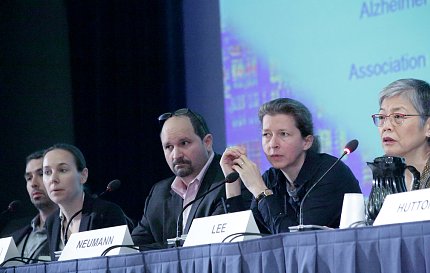NINDS Holds Summit to Prioritize ADRD Research

Photo: Bill Branson
Dementia—a debilitating condition that impairs memory, thought processes and functioning—affects as many as 47.5 million people worldwide, with 7.7 million new cases occurring each year, according to the World Health Organization. Although Alzheimer’s disease accounts for most cases of dementia, about 20 to 40 percent of cases are caused by other, lesser-known forms often referred to as Alzheimer’s disease-related dementias (ADRD).
NINDS recently sponsored a 2-day ADRD summit at Natcher Conference Center to bring together internationally recognized experts, investigators, physicians, non-profit groups and patient caregivers to discuss advances in the field as well as challenges and opportunities for future research on these disorders, which include frontotemporal, Lewy body, mixed and vascular dementias.
The goals of the meeting were to build on progress from the 2013 research recommendations, refine and add new recommendations based on recent scientific discoveries, solicit input from stakeholders and update priorities and timelines.
“This is an example of what makes NIH a great place,” said NINDS director Dr. Walter Koroshetz. “In this process, patient advocates, scientists and government officials come together for this bottom-up approach to develop a plan for how to fight these terrible disorders. The process is now in its second phase. The first phase was quite successful as it was incorporated into the bypass budget, which returned a significant increase in funding to NIH for work in Alzheimer’s disease and ADRD.”

Photo: Bill Branson
Dr. Ronald Petersen, professor in the department of neurology at the Mayo Clinic College of Medicine and chair of the Advisory Council on Alzheimer’s Research, Care and Services for the National Alzheimer’s Project Act (NAPA), gave an overview of the NAPA plan.
NAPA, signed into law in January 2011, is a plan to overcome Alzheimer’s disease and related disorders by 2025. To help carry out the plan, in 2012 NIA held a summit to create a multidisciplinary research agenda for Alzheimer’s disease and in 2013 NINDS held the ADRD workshop to set initial research priorities. This year’s summit built on progress since those priorities were created.
“These meetings are not just academic exercises but, in fact, they have real impact on the process and, at the end of the day, dollars and cents,” said Petersen. The summits, he explained, determine the direction of research questions that translate directly into funding opportunities.

Photo: Bill Branson
NINDS organized the summit in collaboration with NIA, NIH’s Office of Disease Prevention, the Foundation for the NIH, Alzheimer’s Association, Accelerate Cure/Treatments for Alzheimer’s Disease, American Heart Association/American Stroke Association, Association for Frontotemporal Degeneration, Axovant Sciences, BrightFocus Foundation and LEAD Coalition.
In preparation for the meeting, more than 80 top dementia researchers, physicians and other experts in the field worked together for 6 months to refine earlier recommendations. They also were charged with evaluating progress and proposing new priorities and timelines based on current science.
Topics included multiple etiology dementias, ADRD health disparities, Lewy body dementias, frontotemporal lobar degeneration and vascular contributions to cognitive impairment and dementia. New this time were sessions on the role of non-governmental disease organizations and on the importance of standardizing dementia terminology.
Dr. David Holtzman, scientific chair of the summit, presented three main themes that cut across all sessions: genetics, environment and aging. Understanding the genetic pathways that contribute to the disorders is going to be critical, especially for developing diagnostics and therapeutics, he said.

Photo: Bill Branson
Another common idea was the need to develop better disease biomarkers—both pre-clinical and clinical as well as those for people in midlife.
At the end of the meeting, Holtzman and the session chairs fielded final questions from the audience and received feedback regarding the research priorities and the way forward.
“What is it that can be done practically within a timeframe?” stressed Dr. Rod Corriveau, an NINDS program director and summit program lead, encouraging researchers with dementia-relevant ideas to apply now for investigator-initiated grants and not to wait for funding announcements to be released.
Summit recommendations will be presented to NINDS’s advisory council in September and then to the NAPA Council in October.
“The testimonies we have heard over the last 2 days are evidence that we all are just one big community trying to solve our problems and they are all important problems. To call everybody a part of your team and get everybody engaged in your problems are probably the best solutions,” said Koroshetz in closing. “These recommendations have a tangible impact for ADRD research and funding. We are ahead of the ballgame.”
